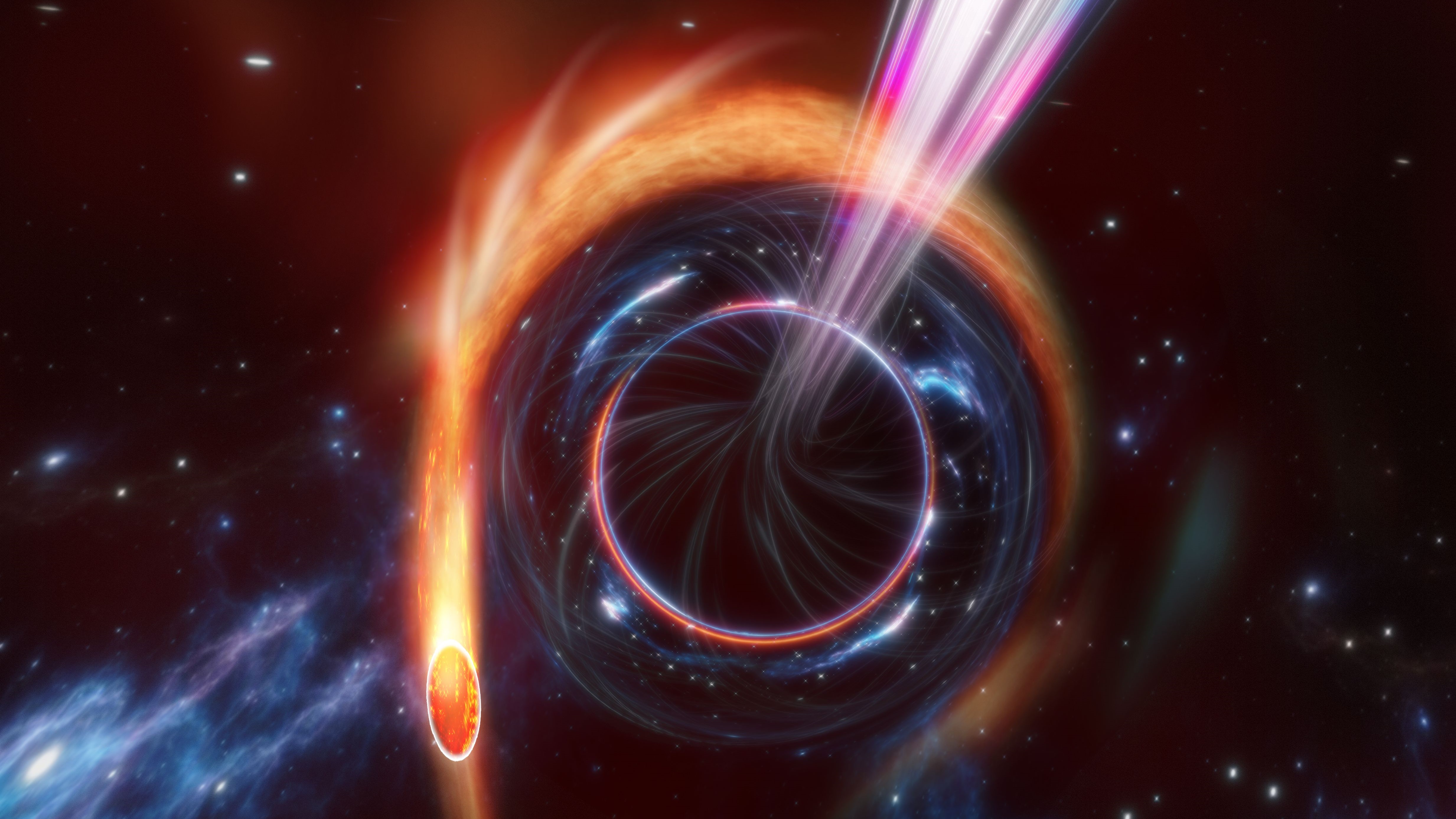Star’s fatal encounter with black hole creates rare luminous flash

A supermassive black hole rips apart a star, causing a bright optical flare to emerge. Image credit: Carl Knox (OzGrav, ARC Centre of Excellence for Gravitational Wave Discovery, Swinburne University of Technology)
In summary
- Astronomers have observed a rare luminous jet of matter created by a supermassive black hole tearing apart a star
- Swinburne researchers were a key part of an international team who made the discovery, utilising more than 20 telescopes on earth and in space.
- The discovery will help astronomers better understand the extreme physics of black holes
Astronomers at Swinburne University of Technology have played an important role in the discovery of a rare luminous jet of matter travelling close to the speed of light, created by a supermassive black hole violently tearing apart a star.
Published in Nature, the research brings astronomers one step closer to understanding the physics of supermassive black holes, which sit at the centre of galaxies billions of light years away.
Swinburne Professor Jeff Cooke, who is also a Chief Investigator for the ARC Centre of Excellence for Gravitational Wave Discovery (OzGrav), was a key member of the research team.
“Stars that are literally torn apart by the gravitational tidal forces of black holes help us better understand what exists in the Universe,” says Professor Cooke.
“These observations help us explore extreme physics and energies that cannot be created on Earth.”
Supermassive, super rare and super far away
When a star gets too close to a supermassive black hole, the star is violently ripped apart by tidal forces, with pieces drawn into orbit around the black hole and eventually completely consumed by it.
In extremely rare instances – only about one per cent of the time – these so-called tidal disruption events (TDEs) also launch luminous jets of material moving almost at the speed of light.
The co-lead authors of the work, Dr Igor Andreoni from the University of Maryland and Assistant Professor Michael Coughlin from the University of Minnesota, along with an international team, observed one of the brightest ever TDEs. They measured it to be more than 8.5 billion light years away, or more than halfway across the observable Universe.
The event, officially named “AT2022cmc”, is believed to be at the centre of a galaxy that is not yet visible because the intense light from the flash still outshines it. Future space observations may unveil the galaxy when AT2022cmc eventually fades away.
It is still a mystery why some TDEs launch jets while others do not appear to. From their observations, the researchers concluded that the black holes associated with AT2022cmc and other similarly jetted TDEs are likely spinning rapidly.
This suggests that a rapid black hole spin may be one necessary ingredient for jet launching—an idea that brings researchers closer to understanding these mysterious objects at the outer reaches of the universe.
Working together on new discoveries
More than 20 telescopes operating at all wavelengths were a part of this research.
These include the Zwicky Transient Facility in California that made the initial discovery, X-ray telescopes in space and on the International Space Station, radio/mm telescopes in Australia, the US, India and the French Alps, and optical/infrared telescopes in Chile, the Canary Islands and the US, including the W. M. Keck Observatory in Hawaii.
Swinburne postdoctoral researcher Dr Jielai Zhang, a co-author on the research, says that international collaboration was essential to this discovery.
“Although the night sky may appear tranquil, telescopes reveal that the Universe is full of mysterious, explosive and fleeting events waiting to be discovered. Through OzGrav and Swinburne international research collaborations, we are proud to be making meaningful discoveries such as this one,” Dr Zhang says.
The paper, “A very luminous jet from the disruption of a star by a massive black hole,” was published in Nature on November 30, 2022
-
Media Enquiries
Related articles
-

- Astronomy
- Education
- Science
- University
Swinburne’s Professor Matthew Bailes honoured with 2024 Prime Minister’s Prize for Science
Swinburne’s Professor Matthew Bailes has been awarded the 2024 Prime Minister’s Prize for Science for his pioneering work in astrophysics, particularly his discovery of fast radio bursts (FRBs).
Wednesday 09 October 2024 -

- Astronomy
- Science
Swinburne-led fungi experiment blasts off to the International Space Station
An experiment developed by Swinburne has been launched into space, containing three types of fungi: Lion’s Mane, Turkey’s Tail, and Cordyceps.Monday 05 August 2024 -

- Astronomy
High school students work with Swinburne astronomers on the future of space
Swinburne’s Youth Space Innovation Challenge has inspired over 330 Australian teenagers to pursue a career in STEM.
Friday 26 July 2024 -

- Astronomy
- Science
Swinburne appoints new Director of Innovative Planet Research Institute
Leading geodesy expert, Professor Allison Kealy, has been appointed as the inaugural Director of Swinburne University's Innovative Planet Research Institute.
Monday 22 April 2024 -

- Astronomy
- University
OzGrav 2.0: A ‘new era of astrophysics’ launched at Swinburne
The next phase in the world-leading ARC Centre of Excellence for Gravitational Wave Discovery, dubbed 'OzGrav 2.0', launched this week at Swinburne University of Technology.
Wednesday 17 April 2024

